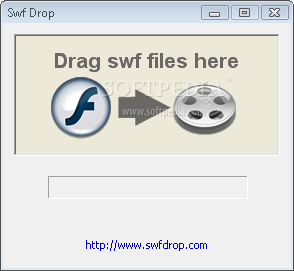Flash is not very good in converting animations in to AVI’s because you lose the animations in the nested movieclips. You can export to .MOV but that’s not a native Windows video codex.
So you want to convert a SWF to AVI (SWF2AVI) or another videofile/codex (without spending any cash)?
As the title of this post suggest: I have written about this subject before: in part 1 and part 2.
And I found a new freeware tool to help you convert your SWF: www.swfdrop.com.

Remember: I have nothing to do with this program, I only think it’s useful.
This project is also freeware and more up-to-date: October 2007 (swf2avi is last updated in 27-08-2002 & swf>>avi is last update in 07.20.2005).
“SWFDROP” is the SWF converter for Windows to convert Flash SWF file format to AVI format. It’s the best tool to successfully convert any Flash 6/7/8/9 SWF file into a video AVI file that you can play with Windows Media Player (or any video player), where all other tools dont work. These, along with a variety of video encoding options, make SWFDROP the best choice for you productivity!
A little preview: you can figure it out, trust me.
It’s very easy to use, you can use the codex installed on you computer and it’s very fast
- make this movie the same size as the original
- use the same frame rate
- only difference with to movie you want to load is the number of frames: use the number that you want (for example: 1000)
Because swf2avi is based upon as2, this code is also as2
[as]
// code in frame 1
loadMovieNum(‘name_of_the_movie_you_want_to_render.swf’, 1);
stopAllSounds();
[/as]
